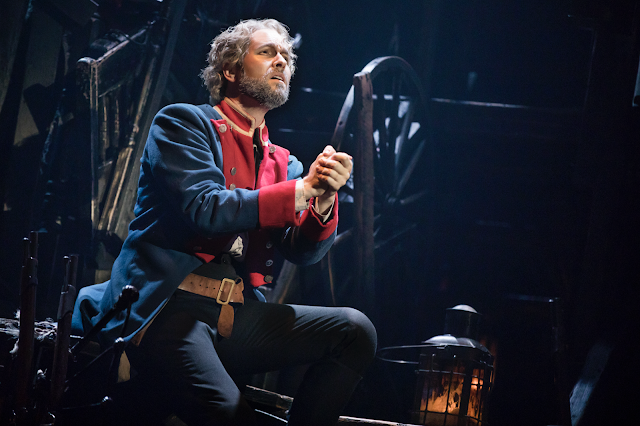After 32 years, Les Miz continues to bring it home
This musical and I go way back. By age five, I could sing every word to "Lovely Ladies" and had deemed Cosette my ultimate idol. Twenty-five years later, Les Miserables (Les Miz for short) holds the same power over me — and I know I'm not alone.
Les Miz, based on the book by Victor Hugo, is now in its 32nd year, having played to more than 70 million people in 44 countries and 22 languages. It's the fifth-longest-running Broadway musical of all time. And if the enthusiastic reception at the Marcus Center on opening night is any indication, Boubil and Schonberg's masterpiece continues to keep a strangle hold on Milwaukee-area hearts.

Set in 19th century France, Les Miserables is a story of redemption, revolution, unrequited love, and sacrifice — an ode to the human spirit. It's simultaneously tragic, uplifting, and soul-stirring. The central figures are Jean Valjean, the fugitive ex-convict on a journey to become an honest man, and the pious Inspector Javert, who has hunted Valjean for decades in the name of law and duty.
Then there's Fantine, a young factory worker forced to turn to prostitution to support her sick child, Cosette — who is eventually taken in and raised by Valjean. Fast forward 10 years and there's Marius and Enjolras, young men and students on the verge of revolution, and Eponine, a girl from the streets who loves Marius and must watch him fall for the now-grown Cosette. Oh, and don't forget the fan favorites and comic relief, innkeepers and cons Monsieur and Madame Thénardier.
It's a lot to digest in a nearly three-hour show, but this superb national touring casts makes every moment worthwhile. Rather than operatic vocals, Nick Cartell brings a four-octave frontman vibe to Valjean, in the best and most exciting way. In softer moments, his voice entrances, and his rendition of the moving "Bring Him Home" is absolutely exquisite — as good as anything you'd find on Broadway. Fantine, the angel-voiced Mary Kate Moore, gives us a beautiful "I Dreamed A Dream" — her voice big, clear, and effortless.

The women of the revolution — a grown-up Cosette and Eponine, played by Jillian Butler and Emily Bautista, respectively — are each incredibly strong. With one a sweet soprano and the other a sky-high belter, these parts can sometimes play out as shrill or try-hard. Butler and Bautista consistently strike the perfect chord.
Bringing the laughs, Allison Gunn nails Madame Thénardier, perfectly lacking in any kind of finesse. J Anthony Crane's Monsieur Thénardier, though plenty animated, left me wondering if his talk-singing was intentional or due to illness.
If there were time and attention span to heap praise on each and every member of the cast, I would. Alas, let's talk about the gorgeous sets and lighting that brings the world of Les Miz to stunning life. Artful lighting lends all the drama of a Renaissance painting. The freshened set design is based on Victor Hugo's own sketches. Scene transitions from city streets to a factory floor to an ivied courtyard to a towering barricade — it's all seamless and larger than life.

But it's the little things in this production of Les Miserables that truly make it a master work; things that are either new additions or simply things one notices upon repeat viewings. For instance, there's such palpable tension between Valjean and Javert (shout out to understudy Steve Czarnecki) just before "Who Am I?" The two fix each other with a nose-to-nose stare, menacing and silent — one of the only moments in the show not backed by the orchestra. It's chilling.
Even the supporting characters deliver on nuance. There's the booze-loving revolutionary, Grantaire, and his particular fondness for the little street urchin, Gavroche. Keep an eye on these two during "Drink With Me" and the moments following the fall of Gavroche at the barricade — and keep a Kleenex handy. Better yet, keep a Kleenex handy throughout. There's such richness in the small moments and rapture in the production as a whole, it's easy to be swept away in a tide of emotion. Ugly crying? You bet.
Following the resounding and emphatic standing ovation for this touring production of Les Miz, it's a great comfort to know that a show that so speaks to me also speaks to my fellow theatergoers. Though she's pushing 33, Les Miserables stands the test of time and trends. Magnificent performances, dazzling sets and staging, soaring orchestrations — these things are as timeless as the show's central message: "Even the darkest night will end, and the sun will rise."

















